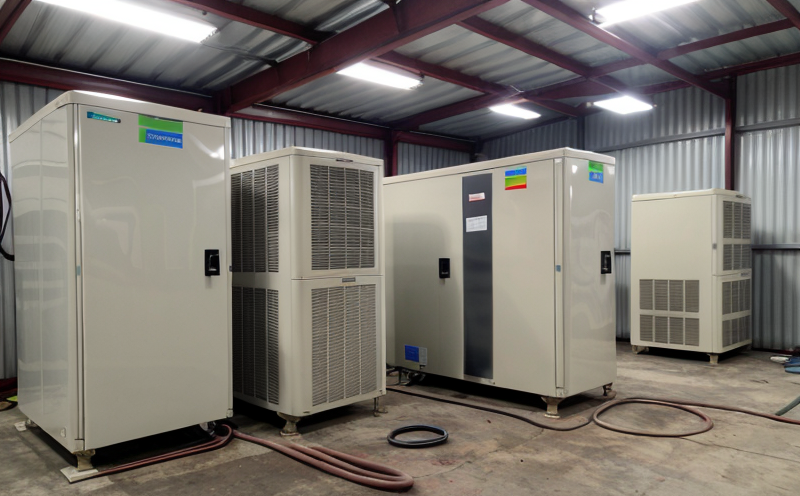EN 378-5 Periodic Leak Testing of HVAC Systems
The European standard EN 378-5 provides a comprehensive framework for periodic leak testing of HVAC systems. This service ensures the integrity and efficiency of HVAC equipment by identifying potential leaks that could lead to operational inefficiencies, increased energy consumption, and safety hazards.
Periodic leak testing is crucial for maintaining optimal performance and compliance with industry standards. The process involves systematic inspection and measurement of refrigerant levels within the system to ensure they are within acceptable limits as defined by EN 378-5. This standard specifies methods for detecting leaks in various components such as compressors, condensers, evaporators, and other critical parts.
The testing procedure typically begins with a visual inspection of the HVAC system followed by pressurization using nitrogen or another inert gas. The system is then left to stabilize before undergoing detailed leak detection using sophisticated equipment like halogen testers or infrared cameras. These tools help pinpoint even the smallest leaks, which are often difficult to locate manually.
The results from these tests are meticulously recorded and reported according to EN 378-5 guidelines. Compliance officers and quality managers rely on this data to make informed decisions about necessary repairs or replacements. By adhering strictly to this standard, organizations demonstrate their commitment to sustainability and operational excellence.
One of the key benefits of periodic leak testing is its ability to prevent costly repairs down the line by catching issues early in their development stages. Moreover, it enhances overall safety within facilities where HVAC systems play a vital role in maintaining comfortable environments for occupants.
In addition to preventing leaks from forming, regular inspections also contribute to extending the lifespan of HVAC equipment. This proactive approach not only saves money but also contributes positively towards environmental conservation efforts by reducing unnecessary emissions associated with refrigerant leakage.
Applied Standards
| Standard Reference | Description |
|---|---|
| EN 378-5 | European standard for periodic leak testing of HVAC systems. |
| ISO 12975 | International standard addressing the prevention and control of refrigerant leaks in air conditioning and refrigeration equipment. |
The EN 378-5 standard is widely recognized for its stringent requirements regarding leak detection methods, acceptable levels of refrigerant loss, and documentation procedures. Compliance with these standards ensures that HVAC systems operate efficiently while minimizing environmental impact.
ISO 12975 complements the efforts made under EN 378-5 by providing additional insights into best practices for managing refrigerants throughout their lifecycle. Together, these two standards form a robust foundation upon which reliable and sustainable HVAC solutions can be built.
Quality and Reliability Assurance
Ensuring the quality and reliability of HVAC systems is paramount in today’s energy-conscious world. Regular periodic leak testing plays a crucial role in maintaining system integrity, which directly impacts both operational efficiency and safety.
By adhering to EN 378-5 during routine maintenance schedules, organizations can identify potential leaks early on, thereby avoiding more significant problems later down the line. Early detection allows for timely repair or replacement of affected components before they cause further damage or compromise system performance.
The quality assurance process encompasses several key areas including proper training of personnel involved in conducting leak tests, adherence to specified testing procedures outlined in EN 378-5, and thorough documentation of all findings. Documentation serves as evidence that standards have been met, providing peace of mind for those responsible for ensuring compliance.
Reliability assurance involves continuous monitoring and evaluation of HVAC system performance post-testing. This includes tracking energy consumption patterns over time to gauge improvements resulting from leak repairs or replacements. Additionally, reliability studies may involve comparing pre-and post-test performance metrics across multiple facilities using similar equipment types.
Use Cases and Application Examples
| Scenario | Description |
|---|---|
| Data Center Cooling Systems | Regular periodic leak testing helps maintain optimal operating temperatures, ensuring reliable data processing without interruptions. |
| Hospital HVAC Networks | Ensures patient comfort and safety by preventing leaks that could lead to contamination or compromised air quality. |
Data centers rely heavily on efficient cooling systems to maintain optimal operating temperatures. Any leak in these systems can result in uneven heat distribution, leading to system failures or downtime. Periodic leak testing ensures that all components are functioning correctly and helps prevent such issues.
In hospitals, maintaining proper air quality is critical for patient care. Leaks in HVAC systems could introduce contaminants into the facility’s ventilation network, posing significant health risks. By regularly performing leak tests according to EN 378-5 standards, healthcare providers can safeguard against these potential hazards.





